| A | B |
|---|
| Name the 4 rocky planets in order from the closest to the Sun to the furthest from the Sun. | Mercury, Venus, Earth, Mars |
| Name the 4 "gas giant" planets in order from the closest to the Sun to the furthest from the Sun. | Jupiter, Saturn, Uranus, Neptune |
| Which planet has the biggest temperature swings between day and night? | Mercury |
| What does the unit of measurement "AU" stand for and how is it defined? | Astronomical Unit, the average distance between the Sun and Earth |
| Jupiter is 5.2 AU's from the Sun. That means that it is _____ times further away from the Sun than _____. | 5.2, Earth |
| The reason that temperatures on Mercury can drop from 427C during the day -173C at night is because it lacks a(n) _____ to slow heat from escaping. | atmosphere |
| Mercury doesn't have much of an atmosphere because it has weak ______ to hold onto the gases and a weak _________ field to protect it from getting blown away by the intense _______ coming from the Sun. | gravity, magnetic, solar winds |
| The planet that gets the hottest at its surface is _____. | Venus, 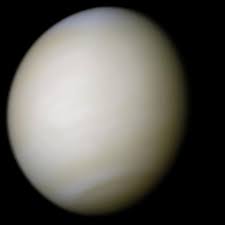 |
| Which planet or planets cannot be seen in their full round shape from Earth? | Mercury and Venus (This is due to the fact that they are closer to the Sun than the Earth is) |
| Which planet is closest in size to Earth? | Venus |
| The atmosphere of Venus is mostly made of _______ which is an important _____ gas. | carbon dioxide, greenhouse |
| Which planet is the brightest object in the night sky, other than our moon? | Venus,  |
| When can Venus be seen in the sky? | Early morning or early evening |
| Venus has a cloud layer made of _______. | sulfuric acid (These clouds give Venus it's hazy white look),  |
| Which planets have life been discovered on? | Earth (We're still looking on Mars and some of the moons of Jupiter and Saturn) |
| Which planets have or have had significant amounts of liquid water on their surface? | Earth and Mars (Mars no longer has liquid water on the surface, but has surface features such as canyons and dried up lake beds that can only be explained by it having flowing water at one time during it's history) |
| How old is Earth (along with all the other planets)? | 4.5 billion years old |
| Which of the rocky planets has at least one moon? | Earth and Mars (Mars has 2) |
| Which planet is closest to Earth as far as size? | Venus,  |
| What percentage of Earth's surface is covered by water? | 71% |
Mars is red because it has a large amount of ____ in the soil., 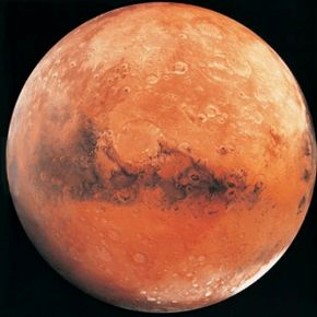 | iron (iron itself isn't red, but when it combines with oxygen atoms, it forms rust, which is red),  |
| Which planet has a volcano that is 2.5 times taller than Mt. Everest and a canyon that is as long as the United States and 3 times deeper than the Grand Canyon? | Mars,  |
| Mars has 4 seasons, just like Earth, because it has a similarly ______. | tilted axis |
| Like Venus, 95% of the atmosphere is made of carbon dioxide. What are two reasons Mars doesn't get hot like Venus? | 1) Mars is much further from the Sun 2) The atmosphere is much thinner and less dense than on Venus (so it can't trap as much heat) |
The polar ice caps on Mars are made of frozen _____.,  | carbon dioxide,  |
Where has water been currently detected on Mars?,  | Underground,  |
| Which planet can have very large dust storms? | Mars,  |
| Asteroids are made of _____ and ______. | Rock and metal (Just like good music) |
| Where are most of the asteroids in the asteroid belt located? | Between Mars and Jupiter,  |
| What's the only thing that can survive on Venus? | Chuck Norris, of course!!,  |
| All of the gas giant planets have thick atmosphere’s of mostly _________ and some _______ along with small amounts of other gases. | hydrogen, helium |
| Which planets are sometimes referred to as "Ice Giants"? | Uranus and Neptune, 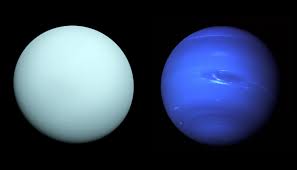 |
| What happens to temperature on a "Gas Giant Planet" as you move from the outer atmosphere toward the middle? | It goes up (For example, Jupiter's outer atmosphere is about minus 160 Celsius while at the center, the temperature is around 30,000 Celsius) |
| Which of the "Gas Giant" planets have rings? | All four of them (Jupiter, Saturn, Uranus, and Neptune all have rings, but only Saturn has rings that are clearly visible through telescopes on Earth) |
| The smallest planet in the solar system is _____ while the second smallest is ______. | Mercury, Mars |
| The biggest planet in the solar system is _____ while the second biggest is ______. | Jupiter, Saturn |
| The bands of swirling clouds on Jupiter are caused winds that are produced by _________ currents due to the large temperature difference between the very cold surface and the very hot interior of the planet | convection |
Which planet is shown below?, 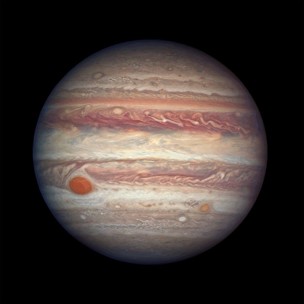 | Jupiter,  |
Which planet is shown below?, 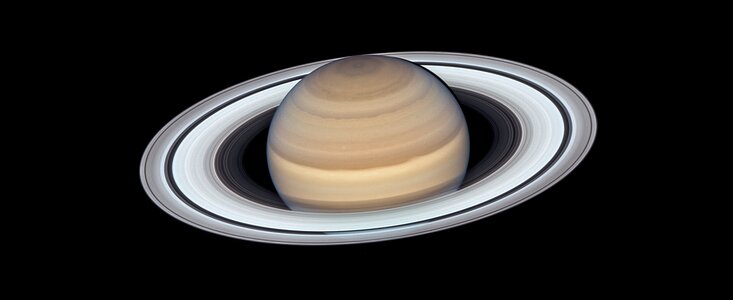 | Saturn,  |
| Which planet has the most highly visible rings? | Saturn,  |
Which planet is shown below?, 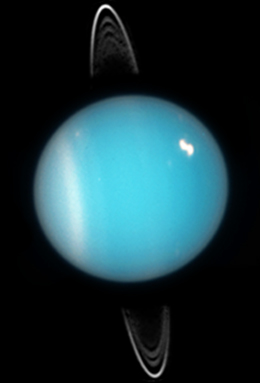 | Uranus,  |
| Which planet has its axis turned on its side? | Uranus,  |
The blue color of Uranus (on the left) and Neptune (on the right) is caused by the presence of ________ in the atmosphere.,  | methane (Hydrogen and helium are still the most common gases, but methane is a gas that is good at absorbing red wavelengths of visible light and reflecting blue wavelengths. In the picture below, Uranus is on the left and Neptune is on the right. You might think that since Neptune is a darker blue that it has more methane, but it doesn't. The milky white mixed in with the blue on Uranus comes from the product of a chemical reaction that occurs when methane reacts with sunlight, and since Uranus is a lot closer to the Sun than Neptune, it has more of this milky white chemical in its atmosphere),  |
| Which planet has the coldest surface temperatures? | Uranus (Which is quite surprising considering that it is much closer to the Sun than Neptune and it has more heat-trapping methane gas in its atmosphere. The best explanation seems to be that the core of Uranus lost a lot of its internal heat when it was struck by a very large object causing it to tilt on its side. That never happened to Neptune. Neptune still has a very hot core and some of that heat helps keep the surface of Neptune slightly warmer than that of Uranus)),  |
| What is the second brightest object in a moonless night sky? | Jupiter (This is actually not technically correct since the international space station is brighter. Also, for short periods of time when Earth and Mars are at their closest, Mars can be brighter than Jupiter, but it's usually not)) |
Which of the inner planets is shown below?,  | Mars (It's often called the "Red Planet." The red comes from oxidized iron "rust" in the soil),  |
Which of the inner planets is shown below?,  | Venus (The white cloudy appearance of the atmosphere is a dead give-away. Also, the fact that it is not full gives the hint that it is one of the planets that is closer to the Sun than Earth),  |
Which planet is shown below?, 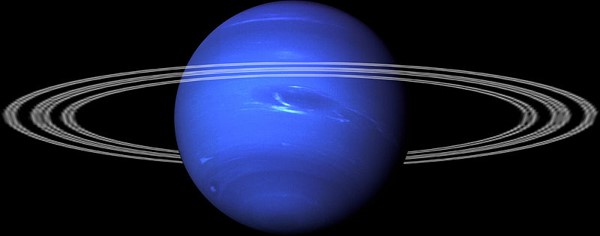 | Neptune (The blue color narrows it down between Neptune and Uranus, but the rings and axis tilt of Uranus are sideways and in this picture, they are not),  |
Which of the inner planets is shown below?, 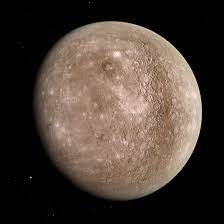 | Mercury (If you see a planet with a rocky surface but no clouds or water, it is either Mars or Mercury. Mars would appear red and you wouldn't see the extensive cratering due to dust storms that cover up or soften the existing craters),  |
| The Kuiper belt is found between _______ and _______. | Neptune, the Oort Cloud, 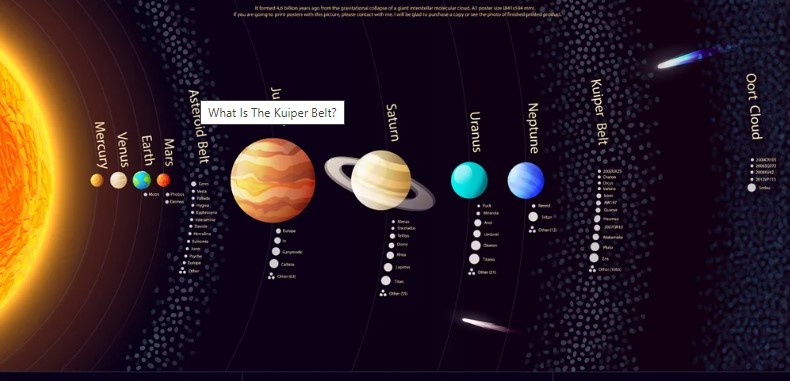 |
| A small fragment (smaller than asteroids) of rock and metal out in space is called a(n) _____. | meteoroid |
| What do you call a small fragment of rock and metal as it's burning up from the friction of colliding with Earth's atmosphere at very high speeds? | meteor (this is the answer I want on the flashcard quiz even though they are often called shooting stars) |
| If you find a piece of rock from space that survived the descent through Earth's atmosphere and the impact with the ground, it would be called a(n) _____. | meteorite |
| Large objects made of ice, rock, and dust that have orbits that come in close to the Sun and then go far out into space before returning are called _____. | comets |
| The furthest region of the solar system is called the _______. | Oort Cloud,  |
If you saw something like this in the night sky but it didn't appear to be moving and it was visible for several weeks, you would be looking at a(n) _____., 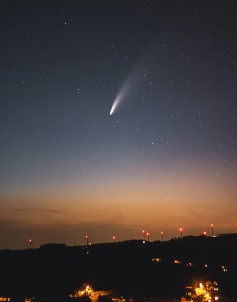 | comet (The comet pictured there is Halley's comet which last visited Earth in 1986 and will return in 2061. The clue that this isn't just a meteor is that it stays up in the sky for a long time, not just a second or so, and it has a curved tail)),  |